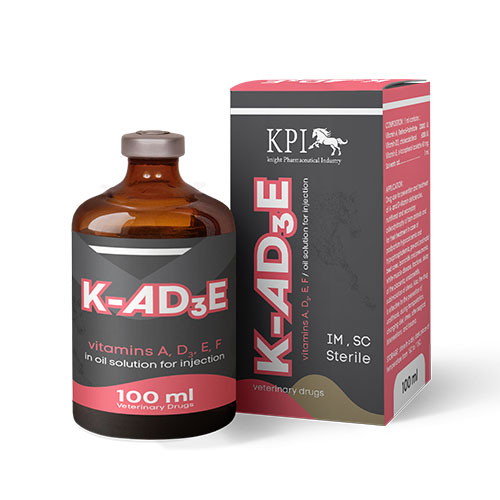
COMPOSITION:
Contains per ml:
Vitamin A, Retinol-Palmitate…………. 20 000 IU.
Vitamin D₃, cholecalciferol ……………. 6000 IU.
Vitamin E, α-tocopherol acetate………… 60 mg.
Solvents ad……………………………………… 1 ml.
PHARMACOLOGICAL CHARACTERISTICS:
Vitamin A, classified among fat-soluble vitamins, plays a crucial role in various physiological processes, including redox reactions in carbohydrate and fat metabolism, as well as mineral and hormonal exchanges.
Its mechanism of action encompasses several key functions:
- Regulation of Biochemical Processes: Vitamin A regulates oxygen uptake in biochemical pathways, inhibits insulin activity, and enhances the conversion of carbohydrates into proteins in the liver.
- Metabolic Activation: It activates the metabolism of calcium and magnesium, crucial for skeletal formation.
- Cellular Maintenance: Vitamin A slows the formation of keratohyalin granules in cell membranes, maintaining their elasticity and integrity. It also supports the normal functioning of vital organs such as the eyes, skin, respiratory tract, digestive system, and reproductive organs.
- Cell Membrane Interaction: It facilitates the interaction between proteins and lipids in cell membranes, ensuring their proper functioning and regulating permeability.
The deficiency of vitamin A particularly affects lysosomal membranes, leading to increased elimination of enzymes. Structural impairments in mitochondrial membranes of hepatocytes can result in respiratory and phosphorylation disorders. Additionally, its deficiency enhances free radical oxidation, disrupts protein biosynthesis in tissues, and affects reproductive functions in animals.
Vitamin D3, another fat-soluble vitamin, primarily influences calcium and phosphorus metabolism from absorption in the gut to excretion from the body. It promotes bone tissue formation, regulates calcium and phosphorus levels in the blood and bone tissue, maintaining their physiological balance.
Vitamin E, also fat-soluble, serves as a regulator of lipid biosynthesis and plays a crucial role in various metabolic processes:
- Protein Synthesis: It increases the levels of myosin and actomyosin, essential for muscle function.
- Antioxidant Properties: Vitamin E prevents the oxidation of fats, fatty acids, and sterols, thereby delaying lipid oxidation and toxic metabolite formation.
- Cellular Stability: It contributes to the structural integrity of cell membranes and intracellular components, ensuring lysosomal stability and preventing dystrophy.
- Epithelial Function: Vitamin E positively impacts the stability and functional activity of surface epithelium in mucous membranes, aiding in digestive and reproductive functions.
Vitamin F influences cholesterol levels, blood coagulation processes, and lipid metabolism. Its deficiency can lead to elevated cholesterol levels, altered blood protein levels, and dermatitis in animals.
APPLICATION:
This medication is indicated for the prevention and treatment of A- and D-vitamin deficiencies, nutritional and secondary osteodystrophy in farm animals. It is also effective in addressing various conditions such as postpartum hypocalcemia and hypophosphatemia, bed sores, bronchitis, pneumonia, white-muscle disease, fractures, placental retention, endometritis, and subinvolution of the uterus. Furthermore, it aids in the prevention of urolithiasis and supports animals during periods of stress, dietary changes, transportation, surgical interventions, and trauma.
DOSAGE & ADMINISTARTION:
For preventive purposes, administer the drug intramuscularly or subcutaneously once every 7-10 days. For therapeutic use, administer intramuscularly once every 5 days until recovery, typically requiring 5-8 injections. Subsequently, continue with prophylactic doses as needed. Orally, administer the drug daily at specified prophylactic doses. The dosage of the drug should be calculated based on the vitamin A content.
Transparent oily liquid from light yellow to light brown color odorless.
| TYPE OF ANIMAL | PARENTERALLY, DOSE, ML | PARENTERALLY, DOSE, ML | Orally DOSE ML /day |
| PREVENTIVE | THERAPEUTIC | ||
| Non milking cows | 10 | 10 | 1.5 |
| Milch cows | 10-12 | 10-12 | 2.5 |
| Young cattle (per 100 kg of body weight) | 2,5-3,0 | 2,5-3,0 | 0,5-0,4 |
| Sows (second half of gestation) | 3,0 | 3,0 | 0,4 |
| Lactating sows | 4.0 | 5.0 | 0.6 |
| Piglets (20-30 kg) | 1.0 | 1,0-1,5 | 0,1-0,12 |
| Mares in foal | 7.0 | 10,0 | 0,6-0,7 |
| Lactating mares | 8.0 | 12.0 | 0,7-0,8 |
| Foals aged 12-6 months. | 2.0 | 3.0 | 0.3 |
CONTRAINDICATIONS:
No contraindications have been established.
PRECAUTIONS:
It is essential to supplement the drug with a balanced diet containing adequate levels of protein, calcium, phosphorus, magnesium, and trace elements for animals.
PACKAGING:
Available in glass vial, 100 ml
STORAGE:
Store in a dry, dark place at temperatures ranging from 5°C to 15°C.
FOR VETERINARY USE ONLY!
